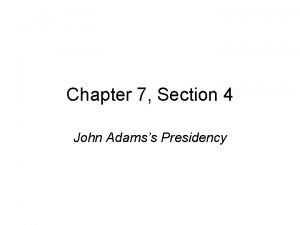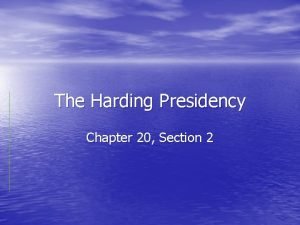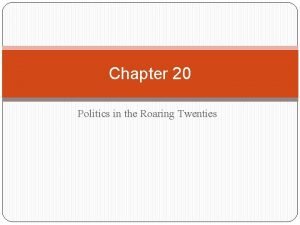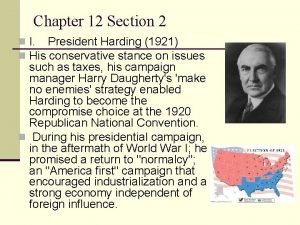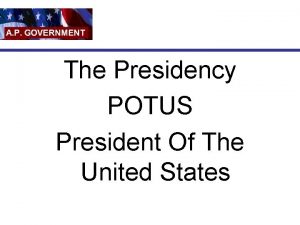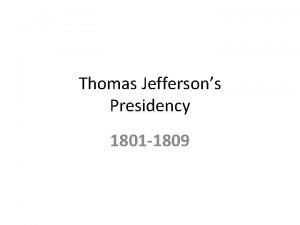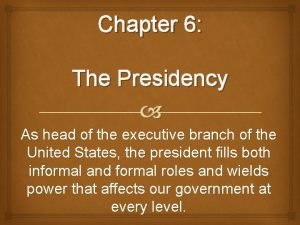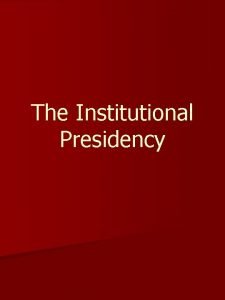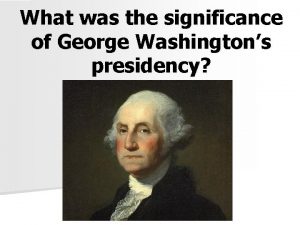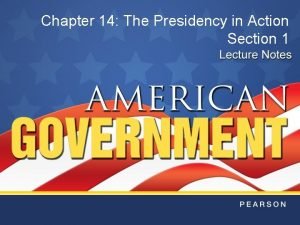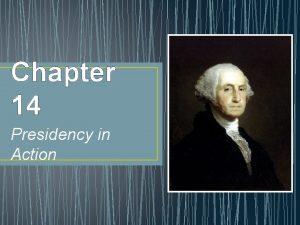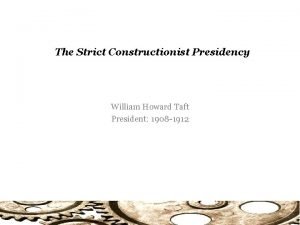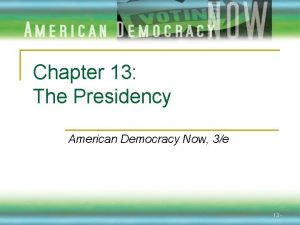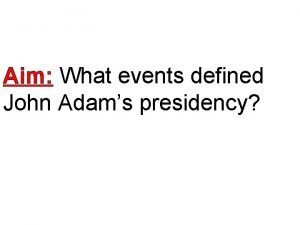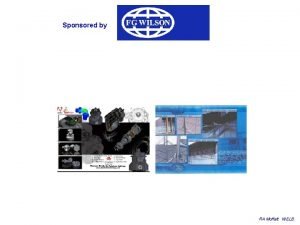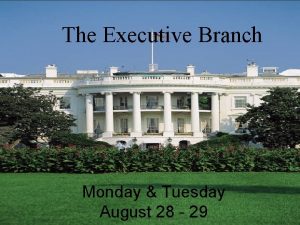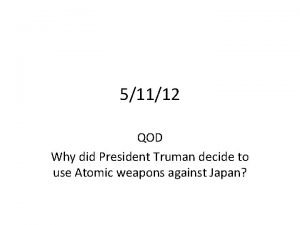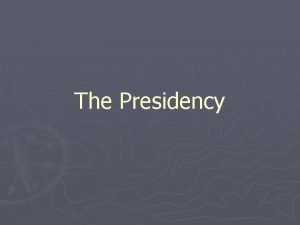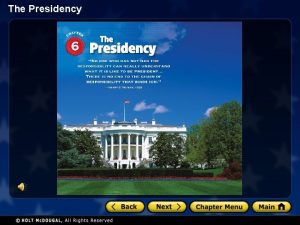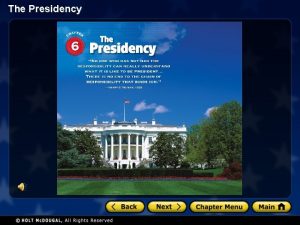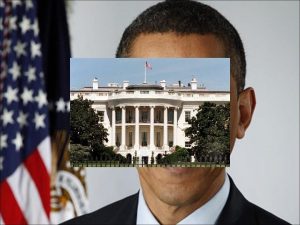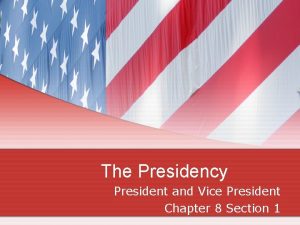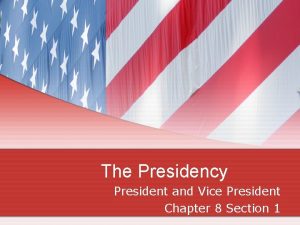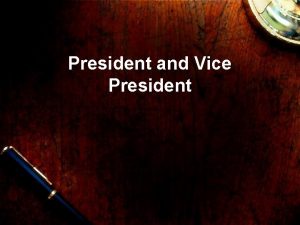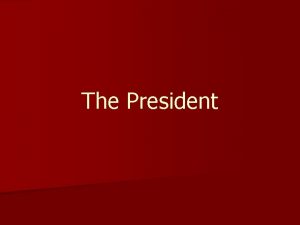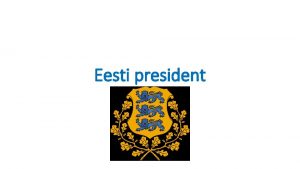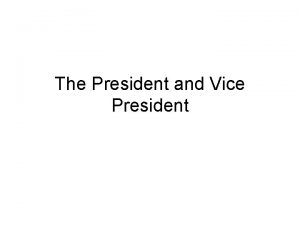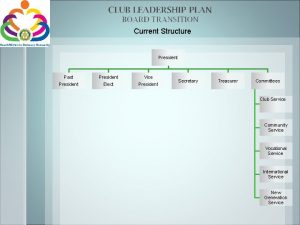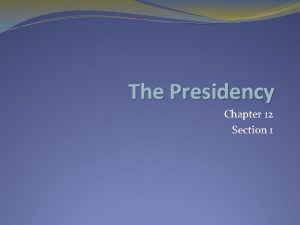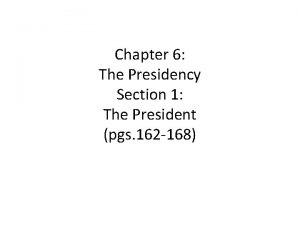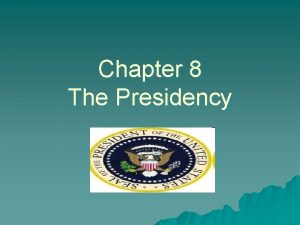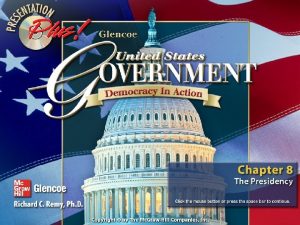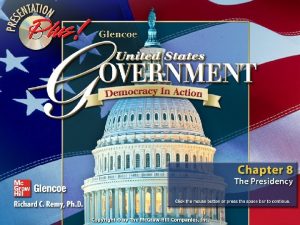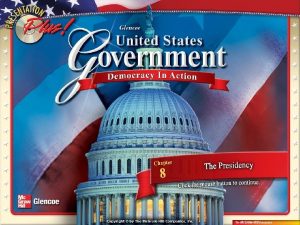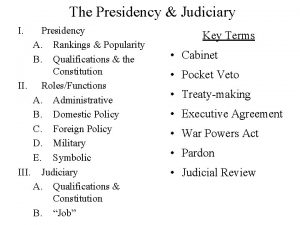The Presidency The Presidency Section 1 The President

































- Slides: 33

The Presidency

The Presidency Section 1 The President • The Constitution names the president as the head of the executive branch of the U. S. government. • The president’s official and unofficial roles include: chief executive, chief administrator, commander in chief, foreign policy leader, chief agenda-setter, chief of state, party leader, and chief citizen.

The Presidency Responsibilities of a President

The Presidency Roles of the President • Some duties outlined by Article II of Constitution • Chief executive • Chief administrator • Commander-in-chief • Chief executive: to see that government programs are carried out and laws passed by Congress are implemented

The Presidency • Commander-in-chief – leader of nation’s military • Has authority to order troops into action, call them home • Congress has duty to declare war • Foreign policy leader – formulates nation’s plans, procedures for dealing with other countries, hosts foreign dignitaries in U. S. • Directs U. S. diplomatic efforts • Diplomacy – the art of negotiating with foreign governments

The Presidency

The Presidency Unofficial Roles • Chief of state—symbolic figurehead of United States • Represents U. S. at major events abroad • Hosts state dinners foreign dignitaries • Party leader—official leader of his/her political party

The Presidency Formal Characteristics of the Presidency

The Presidency Formal Characteristics (cont’d. ) Term of Office • Compromised on four-year term, chance for re-election • Washington served two terms, retired; this became unofficial limit • �President not directly chosen by the people, elected by electoral college

The Presidency

The Presidency Succession • Vice president first in line of succession to presidency • Succession: process of coming after someone • Constitution unclear whether vice president becomes president, or just acts as president • Other guidelines – Speaker of House next in line after vice president

The Presidency

The Presidency

The Presidency Section 2 The Powers of the Presidency • The Constitution grants the president specific executive, diplomatic, military, judicial, and legislative powers. The president also has some informal powers that are not expressly stated in the Constitution.

The Presidency The Burden of Power

The Presidency Executive Powers As chief executive, the president has three main powers: appointing and removing of key executive-branch officials, issuing executive orders, and maintaining executive privilege. Appointment and Removal Powers • Most appointees serve “at the pleasure of the president”; can be removed at any time • Exceptions: federal judges serve for life; only Congress can impeach them

The Presidency Executive Powers (cont’d. ) • Executive orders: formal rules or regulations with force of law. • Executive privilege allows president to refuse to release information. Claim made in interest of national security

The Presidency

The Presidency Diplomatic and Military Powers Diplomatic Powers • Diplomatic recognition: power to formally recognize legitimacy of foreign government Military Powers • 1973: War Powers Resolution requires president to consult with Congress before, during possible armed conflict

The Presidency

The Presidency Legislative and Judicial Powers Legislative Powers • Proposes legislation to Congress • Has power of veto, although Congress can override with 2/3 rds vote

The Presidency Judicial Powers (cont’d. ) Reprieves and Pardons • Reprieve postpones carrying out of sentence, jail time • Pardon releases convicted criminal from having to fulfill sentence • Amnesty grants general pardon to group of offenders for offenses committed

The Presidency

The Presidency Checks on the President’s Powers

The Presidency

The Presidency Debating the Issue

The Presidency Section 3 The President’s Administration • The Executive Office of the President works closely with the president to determine domestic, economic, and foreign policy. • Over the years, the Cabinet has increased in size, and presidents have varied in how much they rely on the Cabinet for counsel.

The Presidency The President’s Staff

The Presidency Executive Office of the President • President’s administration includes all working for executive branch • Most are career employees; at top are presidential appointees, who change when new president elected • Many belong to Executive Office of the President, including White House Office staff, National Security Council, Council of Economic Advisers • Chief of Staff manages staff

The Presidency

The Presidency National Security Council • National Security Council coordinates security with top military, foreign affairs, intelligence officials. Council of Economic Advisers • Created 1946, Council of Economic Advisers provides expert analysis of economy The OMB • Office of Management and Budget develops federal budget, oversees execution

The Presidency

The Presidency The Cabinet • Executive departments responsible for carrying out laws, administering programs, making regulations • As Cabinet, secretaries act as advisory body to president; nominated by president, confirmed by Senate
 President vice president treasurer secretary
President vice president treasurer secretary Chapter 6 section 1
Chapter 6 section 1 Section 4 the presidency of john adams
Section 4 the presidency of john adams Chapter 20 section 2 the harding presidency
Chapter 20 section 2 the harding presidency Chapter 20 politics of the roaring twenties answer key
Chapter 20 politics of the roaring twenties answer key Ch 12 section 2 the harding presidency
Ch 12 section 2 the harding presidency Presidential line of succession
Presidential line of succession Washingtons presidency
Washingtons presidency What were president jeffersons economic policies
What were president jeffersons economic policies Chapter 6 the presidency
Chapter 6 the presidency Institutional presidency definition
Institutional presidency definition Washingtons cabinet
Washingtons cabinet Chapter 14 section 1 the growth of presidential power
Chapter 14 section 1 the growth of presidential power Chapter 14 the presidency in action answer key
Chapter 14 the presidency in action answer key Constructionist theory president
Constructionist theory president Chapter 13 the presidency
Chapter 13 the presidency What events happened during john adams presidency
What events happened during john adams presidency Which trend characterized thomas jefferson's presidency?
Which trend characterized thomas jefferson's presidency? Dimensioning section views
Dimensioning section views Section quick check chapter 10 section 1 meiosis answer key
Section quick check chapter 10 section 1 meiosis answer key Sectional views
Sectional views Section example
Section example Section 1 work and machines section 2 describing energy
Section 1 work and machines section 2 describing energy Mark welb
Mark welb Khi nào hổ mẹ dạy hổ con săn mồi
Khi nào hổ mẹ dạy hổ con săn mồi Robert whelan
Robert whelan Thẻ vin
Thẻ vin 44th president
44th president Thiếu nhi thế giới liên hoan
Thiếu nhi thế giới liên hoan 1 st president of usa
1 st president of usa Thế nào là hệ số cao nhất
Thế nào là hệ số cao nhất World team herbalife salary
World team herbalife salary Executive office of the president
Executive office of the president Axis powers
Axis powers


